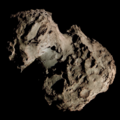 449P/Leonard on 17 November 2020, imaged by the Zwicky Transient Facility | |
| Discovery [1] | |
|---|---|
| Discovered by | Gregory J. Leonard |
| Discovery site | Mount Lemmon Obs |
| Discovery date | 29 September 2020 |
| Designations | |
| |
| Orbital characteristics [4] | |
| Epoch | 20 October 2020 (JD 2459142.5) |
| Observation arc | 34.11 years |
| Earliest precovery date | 5 January 1987 [5] |
| Number of observations | 294 |
| Aphelion | 5.322 AU |
| Perihelion | 1.875 AU |
| Semi-major axis | 3.598 AU |
| Eccentricity | 0.47899 |
| Orbital period | 6.82 years |
| Inclination | 15.459° |
| 242.571° | |
| Argument of periapsis | 176.652° |
| Last perihelion | 23 November 2020 |
| Next perihelion | 25 September 2027 |
| TJupiter | 2.853 |
| Earth MOID | 0.8872 AU |
| Jupiter MOID | 0.0613 AU |
| Physical characteristics [6] | |
| Comet total magnitude (M1) | 8.6 |
| Comet nuclear magnitude (M2) | 17.7 |
| 17.5 (1987 apparition) | |
449P/Leonard is a periodic comet that orbits the Sun once every 6.83 years. [7] Studies in 2022 show that 449P was a rediscovery of a previously lost comet that was spotted in 1987. [2] [8]

